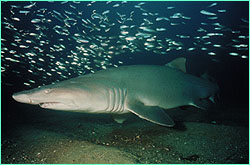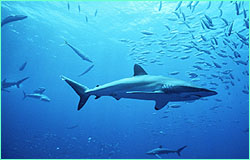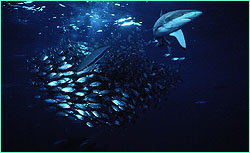 |
 |
 |
Exploding Myths Part 3 (back to Part 2) NOVA: Can sharks survive finning (when the dorsal fin is cut off for shark-fin soup and the animal released)? Gruber: In nature, occasionally fins get bitten off with no detriment to the shark, and finned sharks have been caught in a starved state during shark-fishing tournaments. But generally finning kills sharks.
Gruber: One group, the sand tigers, has evolved a true survival-of-the-fittest strategy in the womb. Six to eight embryos are produced in each of the mother's two oviducts. The strongest, fastest-growing sibling kills and consumes the others, so that sand tigers typically have two babies, one per oviduct. This is really a great system, as only the best are born. They're big, up to two-fifths the length of the mother. It's a good head start. Otherwise, the different groups of sharks have evolved all the usual developmental strategies—egg laying, egg laying with eggs retained, even up to a real maternal-fetal connection via an authentic placenta.
Gruber: Yes and no. All cartilage—shark cartilage, cow cartilage, whatever—possesses an anti-angiogenesis (AG) factor that, if injected into a solid tumor, will cause the growth to dry up, shrink, and die. Merely eating shark cartilage will give you some extra calcium, but it will be useless against cancers, as no complex molecules pass through the gut wall. Even if the AG factor got through, how and why would it seek out the tumor like a magic bullet? I say if you want calcium take supplements! This hocus pocus is bad for cancer victims, as they get false hope and discard their effective but uncomfortable treatments for snake oil, and they die. And it is bad for sharks, as they have to give up their skeletons for nonsense.
Gruber: The Registry of Tumors in Lower Animals housed at the Smithsonian Institution has recorded tumors, and I have seen things that appear to be neoplasms. But sharks are very resistant to cancers. Carl Lauer at the Mote Marine Laboratory in Florida has shown that the usual carcinogens do not induce cancer. I have several theories as to why they're so resistant. First, the AG factor in their cartilage is very strong in the living shark, though they still have the same problem of getting it to a potential tumor site. Next, sharks have a primitive but very potent immune system—the key to cancer resistance. Finally, shark DNA is very conservative and resistant to mutations.
Gruber: New evidence suggests that the cartilaginous fishes to which sharks belong may be the oldest of the jawed vertebrates. So they are ancient. Indeed, some sharks survived as a group for 200 million years. (They are all gone now; no trace of them exists outside of some teeth and scales.) But modern sharks, skates, and rays arose only 30 million years ago. The biological definition of primitive is "only slightly evolved from early antecedent forms." Modern sharks are greatly evolved from the stem cartilaginous fishes and contain some of the most derived, sophisticated animals on the planet. So they are anything but primitive. Photos: (1,4,6) ©Doug Perrine/INNERSPACE VISIONS; (2,5,9,10,14-16) ©Howard Hall; (3,7,8,12) ©Michele Hall; (11) ©David B. Fleetham/INNERSPACE VISIONS; (13) ©Howard Hall/INNERSPACE VISIONS. Cocos Island | Sharkmasters | World of Sharks | Dispatches E-mail | Resources | Site Map | Sharks Home Editor's Picks | Previous Sites | Join Us/E-mail | TV/Web Schedule | About NOVA Watch NOVAs online | Teachers | Site Map | Shop | Search | To Print PBS Online | NOVA Online | WGBH © | Updated June 2002 |
 Sand tiger shark
Sand tiger shark
 A hammerhead parade.
A hammerhead parade.
 Silky sharks
Silky sharks
 A silky flashes through a bait ball.
A silky flashes through a bait ball.